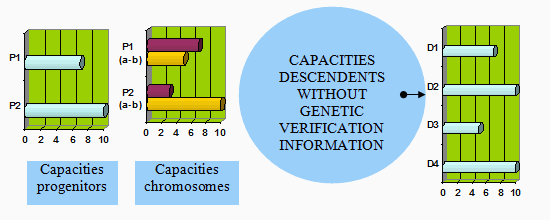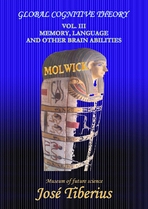5. Evolutionary genetics and neuroscience
5.a) Brain memory inheritance
Section VI of the Conditional Evolution of Life proposes the EDI Study - Evolution and Design of the Intelligence to its validation.
The statistical research achieved excellent results, and it is available online in the book the EDI Study.
While in the analysis of the intelligence, it is possible to speak about a general one; in memory studies, it is not feasible due to its diversity.
Research might also deal with the evolution of mathematical memory, which demands certainty in the answers and should behave like the evolution of intelligence.
At the same time, it would not be surprising that other types, like standard and semantic memories with the characteristic of admitting errors, were a consequence of the same genetic load of the math memory, but under different assumptions of the verification of the information.
In other words, for the semantic memory, our brain with the genetics of both ancestors develops a mechanism without requiring the confirmation between them. Likewise, the intuition is compelling, but one cannot be sure about its proposals.
The verification of memory heritability involves a more complicated model than intelligence. It will require measurements of partial capacities for the different potentials of the memory stratum and specific memories.
Neuroscience should provide models allowing studies about memory in depth, but despite the advances produced, it seems that a robust model still does not exist.
The figure shows the effect on the cognitive capacities of the possible descendants within the opposite assumption to the LoVeInf method. The expression will follow a mathematical law of addition instead of the law of intersection in the evolutionary genetics of the intelligence.
The design implies a simplification of the model; it assumes that the addition is equal to the potential of the significant gene.
without the LoVeInf method

The evolution of standard memory would follow the case of the figure.
Evolutionary genetics and cognitive neuroscience models for medium and long-term standard memory need to take into account the following aspects:
Reliability of standard memory
The potential of this memory will depend on a similar mechanism to the intuition that would imply the opposite hypothesis of the functionality of the method Logical Verification of Information (LoVeInf).
A mistake from the standard memory is not severe and, therefore, it does not require the levels of reliability that guarantees the cited LoVeInf method.
The effect of simple complementarity between intelligence and memory
The operational complementarity implies that each additional unit, for example of intelligence, will increase the total potential in the quantity of the full memory. In these cases, it might follow a mathematical law of a more or less attenuated multiplication.
The section about Complementary Characters and the Origin of the Species in title IV of the Conditional Evolution of Life book comments this effect of complementarity within general evolution.
The effect of complex complementarity between intelligence and memory
Memory depends on its genetic structure and the power of its manager –intelligence; therefore, its efficiency will vary with the possible effects of complementarity.
The complex complementarity takes place due to the involvement of the intelligence in the processes of the global information system of the memory; it is to say, as a memory manager, and not of his normal logical operations.
The brain’s reasoning capacity will rest on the logical processor and the available information (simple complementarity effect); at the same time, this data depends on the processor when working both for the classification and storage, and retrieving of the info (complex complementarity effect)
5.b) Language, semantic memory and reasoning
In the specific case of the research in evolutionary genetics and neuroscience of semantic memory, the linguistic intelligence might act choosing a word depending on the first proposals received.
It is opportune to emphasize that, in this occasion, it is a matter neither of the employ of the method Logical Verification of Information (LoVeInf), proposed for the evolution of the intelligence nor his contrary but a different one, which would act as intuition, but much faster.
The LoVeInf method expects to receive many proposals of the involved mechanism and needs uniformity to the acceptance. Now it takes place with the first proposals with a minimum threshold.
A numerical example would be to validate the first five words which appear 50 times; this way, it is not necessary to wait for the completion of the work of thousands or million neurons that might be involved.
The global language system will have as primary elements, on the one hand, the semantic memory and linguistic intelligence. On the other hand, a manager of the physiological character of the language itself.
The complementarity power of two characters not demanding the method LoVeInf should be far superior to when applying the LoVeInf. It could be the reason that the capacity of human language and its evolutionary process are surprisingly powerful from the perspective of the neuroscience.
The inheritance and evolution of this combined power might be a subject of study through statistical analysis because there are methods to measure the variables involved.
A philosophical trend supports an active constituent of genetics in language. The linguist Noam Chomsky is the most important representative of innatism in contraposition to constructivism. Chomsky affirmed, many years ago, to have identified common elements to all the languages of the human beings, what it meant a genetic predisposition to the language development although it is not clear if he included as humans the Neanderthal and Denisovans.
The language genetic nature reinforced with the discovery of a particular gene affecting the creation of phrases without disturbing other personal capacities of an entire family.
